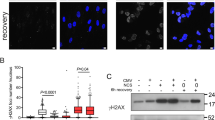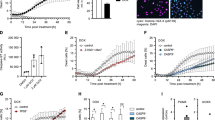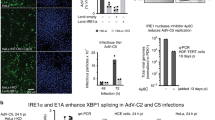Abstract
We have previously shown that adenoviral-mediated interferon α (Ad-IFNα) is cytotoxic both to cells that are sensitive to recombinant interferon α (IFNα) and to cells which are resistant to IFNα. The cancer cell-specific cytotoxic effects of Ad-IFNα involve three different mechanisms: 1. The direct effect of IFNα production causing cancer cell death in IFNα sensitive cells (1); 2. The direct effect of Ad-IFNα infection and high levels of IFNα expression in IFNα resistant cancer cells (2); and 3. The indirect effect of the Ad-IFNα bystander factors produced (2–4). After Ad-IFNα infection, the cells produce a large amount of perinuclear localized IFN protein. This protein over-load could be a major factor in the direct cancer cell death of those cells infected with Ad-IFNα compared with the indirect cytotoxic effects of the bystander factors produced. Here, we investigated whether a component of Ad-IFN-induced cell death involves protein overload-induced endoplasmic reticulum (ER) stress, using an IFNα-resistant human bladder cancer cell line (KU7), and the normal human urothelial cell line, TERT-NHUC, as preclinical models. We found that the two ER stress response pathways examined were activated in KU7 cells. In contrast, following treatment of the normal TERT-NHUC cells with Ad-IFNα, no ER stress signals were observed. In addition, no ER stress related changes were seen, when KU7 cells were exposed to conditioned medium from Ad-IFNα-treated KU7 cells, indicating that bystander produced cytotoxicity did not involve ER stress. After 24 h of Ad-IFNα infection, the KU7 cancer cells produced spliced X-box binding protein 1 and activating transcription factor 6 protein (ATF6), evoking an ER stress response that could contribute to Ad-IFNα induced apoptosis in these cancer cells. In addition, GADD153/CHOP, GADD34 and BAX were also subsequently modified following activation of the ER stress pathways, thereby signaling downstream effectors in a pro-apoptotic manner.
This is a preview of subscription content, access via your institution
Access options
Subscribe to this journal
Receive 12 print issues and online access
$259.00 per year
only $21.58 per issue
Buy this article
- Purchase on Springer Link
- Instant access to full article PDF
Prices may be subject to local taxes which are calculated during checkout




Similar content being viewed by others
References
Papageorgiou A, Lashinger L, Millikan R, Grossman HB, Benedict W, Dinney CP et al. Role of tumor necrosis factor-related apoptosis-inducing ligand in interferon-induced apoptosis in human bladder cancer cells. Cancer Res 2004; 15: 8973–8979.
Benedict WF, Tao Z, Kim CS, Zhang X, Zhou JH, Adam L et al. IFNα causes marked regression of human bladder cancer growing orthotopically in nude intravesical Ad- mice and overcomes resistance to IFNα protein. Mol Ther 2004; 10: 525–532.
Zhang X-Q, Yang Z, Dong L, Papageorgiou A, McConkey D, Benedict WF . Adenoviral- mediated interferon α overcomes resistance to the interferon protein in various cancer types and has marked bystander effects. Cancer Gene Ther 2007; 14: 241–250.
Zhang X-Q, Dong L, Chapman E, Benedict WF . Conditioned medium from Ad-IFNα infected bladder cancer and normal urothelial cells is cytotoxic to cancer cells but not normal cells: Further evidence for a strong bystander effect. Cancer Gene Ther 2008; 15: 817–822.
Benedict WF, Fisher MB, Cutler DL, Alice A, Young S, Yang Z et al. Results of a Phase 1 trial with intravesical Ad-IFN-α/Syn3 for superficial bladder cancer including putative marker studies (abstract). In: Proceedings of the 100th Annual Meeting of the American Association for Cancer Research, 2009. Abstract#1449.
Fisher MB, Zhang XQ, McConkey DJ, Benedict WF . Measuring soluble forms of extracellular cytokeratin 18 identifies both apoptotic and necrotic mechanisms of cell death produced by adenoviral-mediated interferon alpha: possible use as a surrogate marker. Cancer Gene Ther 2009; 16: 567–572.
Zhang XQ, Dunner K, Benedict WF . Autophagy is induced by adenoviral-mediated interferon α treatment in interferon resistant bladder cancer and normal urothelial cells as a cell death protective mechanism but not by the bystander factors produced. Cancer Gene Ther 2010; 8: 579–584.
Lin JH, Walter P, Yen B . Endoplasmic reticulum stress in disease pathogenesis. Annu Rev Pathol Mech Dis 2008; 3: 399–425.
Gross A, Jockel J, Wei MC, Korsmeyer SJ . Enforced dimerization of BAX results in its translocation, mitochontrial dysfunction and apoptosis. EMBO J 1998; 17: 3878–3885.
Suzuki M, Youle RJ, Tjandra N . Structure of Bax: Co-regulation of dimer formation and intracellular localization. Cell 2000; 103: 645–654.
Acknowledgements
This study was supported by a GU SPORE in Bladder Cancer (P50 CA91846) Project 5 to WFB.
Author information
Authors and Affiliations
Corresponding author
Ethics declarations
Competing interests
The authors declare no conflict of interest.
Rights and permissions
About this article
Cite this article
Zhang, XQ., Yang, Z. & Benedict, W. Direct gene transfer of adenoviral-mediated interferon α into human bladder cancer cells but not the bystander factors produced induces endoplasmic reticulum stress-related cytotoxicity. Cancer Gene Ther 18, 260–264 (2011). https://doi.org/10.1038/cgt.2010.76
Received:
Revised:
Accepted:
Published:
Issue Date:
DOI: https://doi.org/10.1038/cgt.2010.76



